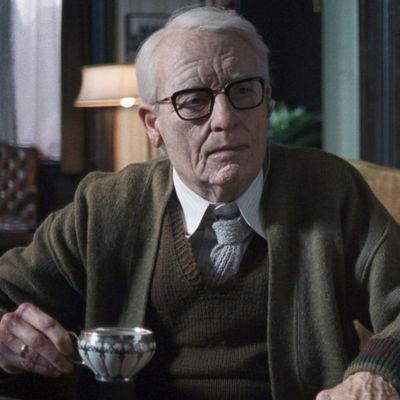
Suspiria takes place in Berlin in 1977, and boy, does it ever. Luca Guadagnino’s new film is very self-consciously not just about witches and modern dance; it’s also tied to the events of the “German Autumn” of that year, when the ghosts of the nation’s past erupted in an unrelenting stream of political violence. To aid both those who saw the film in its opening weekend, as well as those who want to get up to speed before stepping into the theater, here’s a primer on the history behind the movie.
Germany After World War II
I’m going to assume you know about World War II, the Holocaust, and the Berlin Wall, the latter of which gets prominent placement in Suspiria next to the Markos Dance Academy. Where we need to start, then, is in the period immediately after the war. Though the Allied powers did hold Nazi leadership accountable for crimes against humanity at the Nuremberg trials, as Tony Judt writes in Postwar, eradicating lower-level Nazis from public life soon proved “not practicable.” Germany after the war contained 8 million former Nazis, many in professions the Allies relied upon to rebuild a functioning society, like doctors, judges, and civil servants. And, Nazi or not, ordinary Germans often resisted reckoning with the violence carried out in their name. The Allies made watching footage of concentration-camp scenes mandatory for those who wanted ration cards; Judt quotes the author Stephan Hermlin, who reported that most of the audience in one Frankfurt theater simply turned their heads away.
The result was a society where actual Nazis and actual Nazi beliefs were both still widespread. As Judt details, in 1946, 37 percent of Germans polled in the American Zone said the mass murders of the Holocaust were “necessary for the security of Germans.” Even in the early 1950s, that same percentage of West Germans said the country would be “better” if it had no Jews, while 25 percent had a “good opinion” of Hitler. As the years went on, these sentiments subsided, but the sense of victimization did not. Hitler remained a convenient scapegoat, as conventional wisdom held that the crimes of the Nazi era were his and his alone.
After what Luca Guadagnino calls “20 years of obliviousness,” the Nazi years were introduced into German school curricula in the early ’60s, just in time to enter the minds of the youths who would be on the front lines of the decade’s subsequent cultural shifts. In Germany, the late-’60s generation gap was even starker than in other Western countries, as young people born during or after the war woke up to the fact that their parents’ generation had perpetrated one of history’s greatest monstrosities. As Gudrun Ensslin, a founder of the Red Army Faction, put it after West Berlin police killed a young protester in 1967: “This is the generation of Auschwitz we’ve got against us. You can’t argue with people who made Auschwitz. They have weapons and we don’t. We must arm ourselves.”
The Red Army Faction
If you’ve seen Suspiria, this was the group that Chloë Grace Moretz’s character supposedly fell in with. If you haven’t: The RAF was a Marxist terror group that emerged out of the more militant fringes of West German counterculture. (Though the RAF received assistance from the East German government, the regime generally considered them unruly dilettantes.) You might have also heard them called the Baader-Meinhof group, after two of their leaders: Andreas Baader, Ensslin’s boyfriend, who as David Clay Large drily notes in Berlin, “seems to have drifted into the radical protest movement less out of conviction than out of a desire for adventure and self-dramatization”; and Ulrike Meinhof, a former journalist who joined the gang after helping Baader escape from prison.
When we see the RAF in Suspiria, most of their original leaders are in jail. After a string of robberies and bombings, Baader, Ensslin, and Meinhof were all arrested in 1972, but a “second generation” carried on in their absence. With the exception of Meinhof, who had been found dead in her cell in 1976, the leaders were convicted on several murder and terrorism charges and sentenced to life in prison in 1977, kicking off a string of events now known as the “German Autumn.”
The ‘German Autumn’
The term refers to a series of kidnappings and other violence the second generation of the RAF undertook in order to force the release of Baader, Ensslin, and their compatriots. (You could argue that really began in the spring during the trial, when the group killed West German attorney general Siegfried Buback, a former Nazi, in a drive-by shooting.) The first kidnapping, of banker Jürgen Ponto, went wrong, as RAF members shot Ponto to death after an apparent struggle. Then, in September, the group abducted Hanns Martin Schleyer, president of the West German employers’ association and a former second-lieutenant in the SS. When the government refused to negotiate, the RAF raised the stakes.
On October 13, an allied Palestinian organization hijacked a Lufthansa flight and threatened to blow up the plane unless the prisoners were released. The plane ended up in Mogadishu, where the West German government pretended the accede to the demands, but instead sent a commando squad who stormed the plane, killed the hijackers, and freed the hostages. (News coverage of this pops up in Suspiria.) After the failure of the hijacking, Baader, Ensslin, and others were found dead in their cells, though, as with Meinhof’s death, the official ruling of suicide was challenged by RAF supporters. Schleyer was murdered the next day, his body left in a car trunk in France. We’re getting outside the purview of the movie, but the RAF would hang around until 1998. In all they were responsible for the deaths of more than 30 people, many of them innocent bystanders.
‘Volk’
The climax of Suspiria involves a pivotal dance called “Volk,” or “the people,” which Manohla Dargis calls, at the risk of understatement, “a loaded idea in German history.” The term in its current meaning first arose in the 19th century, when liberal nationalists in the petty kingdoms and duchies of the former Holy Roman Empire dreamed of uniting the German people into one country, ideally a parliamentary democracy. Those dreams initially died alongside so many others in the failed revolutions of 1848, but in a particularly strong example of the need to be careful what you wish for, they eventually came true a few decades later, when autocratic Prussia swallowed up its smaller neighbors to create a single German state. Still, even in 1916, the word was so identified with democratic ideals that Kaiser Wilhelm II grumbled at the addition of the phrase Dem Deutschen Volke (to the German people) to the exterior of the Reichstag.
But like much European nationalism, what first looked like a romantic dream in the 19th century would turn into a genocidal nightmare in the 20th, as the creation of an in-group of “the German people” also necessitated the creation of an outgroup — in this case, Slavic peoples, as well as Jews. As the first half of the century proved, there was little you could do to non-Germans that could not be justified in the name of the Volk, and it was one of the favorite nouns of Nazi propagandists.
The term was neutral enough to remain in general use following the war, and its appearance in Suspiria shouldn’t be taken as an indication that the choreographers of the Markos Dance Academy harbor latent Nazi sympathies. (Indeed, the violence of the dance could be considered a commentary on the brutality the idea of Volk unleashed.) It’s worth noting, too, that the term got something of a reappropriation in the late ’80s, as activists in East Germany used the phrase “Wir sind das Volk” (we are the people) to protest the communist regime, and then “Wir sind ein Volk” (we are one people) to urge reunification. But its use has recently began to shift back toward the sinister, as right-wing parties have seized on the slogan as a way of protesting immigration.
David Bowie
Finally, no mention of Germany in the ’70s would be complete without a mention of David Bowie, who moved to West Berlin in 1976 and recorded a trio of critically acclaimed albums that inextricably linked him to the city. (Like all movies and TV shows set in ’70s Berlin, Suspiria features a Bowie poster on one character’s wall.) He was one of a few British and American musicians who hung around in Berlin around this time, and one funny thing you notice in reading a lot of books about 20th-century history is how much historians hate them. David Clay Large spends a page in his book detailing the most obnoxious antics of Bowie, Iggy Pop, and Johnny Rotten in their pilgrimages to the “self-conscious enclave of louche living and neo-Weimar ‘decadence,’” concluding, “No doubt Bowie and company would have acted like asses wherever they were at this stage of their lives, but the city of West Berlin, that open-air theater of the grotesque and forbidden, seems to have brought out the worst in them.”





